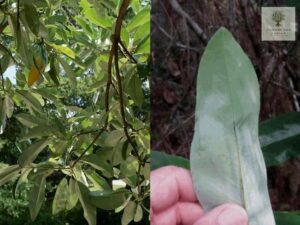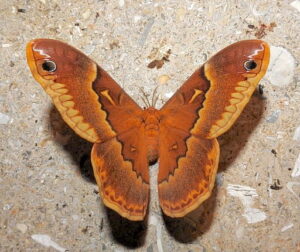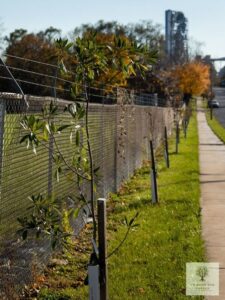Sweetbay Magnolia or Magnolia virginiana
The Sweetbay Magnolia is a proud member of the Magnolia plant family which has 125 deciduous (shedding its leaves fully or partially according to season) and evergreen species in total. The first Magnolia family member was discovered in 1688 from a European garden for the first time. Ever since it’s been cultivated on gardens worldwide to beautify their gardens.

Photo Credit – Channel Chesapeake Bay Program
In the name Sweetbay magnolia, the “Sweetbay” part was given to it, as the foliage of this plant is sweet-bay-like in shape. And the Magnolia name was given to honor French Botanist Pierre Magnol (1638-1715). It is a perennial tree that is native to Eastern USA. Commonly found in wet or swampy sites. Thus it is an excellent choice to grow near-natural pond edges and low areas in the Landscape. Now it is known to be grown in hardiness zones from 5-9.
Common names
The scientific name of Sweetbay Magnolia is Magnolia virginiana which gives the meaning “Magnolia plant of Virginia”. And there are two synonyms as well. They as follows,
- Magnolia virginiana var. asutralis (here australis mean Southern)
- Magnolia virginiana var. parva (here parva means small)
There are many other common names that use for Sweetbay Magnolia. Among them…
Southern Sweetbay, Swamp Bay, Swamp Magnolia, Small Magnolia, Laurel Magnolia, White Bay, White Laurel, Swamp Laurel, Beaver Tree.
Sweetbay Magnolia Foliage
The Sweetbay Magnolia leaves vary from semi-evergreen to evergreen in nature.
1.semi-evergreen means, the leaves tend to be attached to the tree during parts of Dry and Winter seasons. Or tend to be evergreen in mild climates but deciduous in extreme climates like drought seasons. No matter what happens in those rough seasons, the tree recovers very nicely in the Spring period. 2.Evergreen means, The Sweetbay Magnolia remains leafy and green throughout the winter.
The leaf’s color varies from medium to dark green from above, and silver-whitish from underneath. Especially during the Fall season, the leaves turn yellow-brown.

Photo Credit – Plant Image Library and Homer Edward Price
Leaf arrangement of SweetbayMagnolia is alternate, leaf complexity is simple and elliptic to oblong-lanceolate in shape. Leaf tips are pointy or rounded and have taperings in the base. Does not have toothed edges. Has a silvery-silky impression in young leaves, But eventually, the upper surface becomes smooth and glaucous. And they grow about 3 to 6 inches in length.
When you move towards the North and examine the leaves of Sweetbay, you will see that the foliages are smaller and thinner than the Southern Magnolia.
Nature of Sweetbay Magnolia flowers

Photo Credit – Carol Foil
The Sweetbay Magnolia flowers bloom in creamy white color and in single units. The flower is shaped like a cupcake in total and has 3 inches width in diameter. Each flower has 9 to 12 numbers of petals in total and has an attractive lemon-scent-like fragrance. The flower stalk is small, smooth, and grows up to ¾ inches in length.
The Sweetbay Magnolia flowers bloom from late April to early July. But from time to time there may be some instances where one or two blossoms pop during the Summer. Each blossom opens in the morning and closes at night. And they last about 2 to 3 days maximum from the day they bloom.

Photo Credit – Gardening Solutions
To fill your Magnolia tree with flower blossoms during the season, the tree should prefer at least 4 hours of direct sunlight per day.
The Sweetbay Magnolia flowers fade away by early summer. And they are followed up by dark red color seed pods. These seedpods arise from the branches in a corn shape. And eventually, they split open to expose bright glossy Orange-red color seeds.
Is Sweetbay Magnolia a Tree, or a Shrub?

Photo Credit – John Winder
The Sweetbay Magnolia grows up to 12-20 feet in height around the Northern part of its range (in hardiness zone 5-9). But in the southern range, they tend to grow about 50-60 feet in height. Also, A full-grown Magnolia covers a surrounding area of 10 – 20 feet in total.
These trees tend to have upright trunks with horizontal branches. Hence if you do not maintain this tree initially, the natural shape that it will take will vary. Therefore please make sure that you do not plant them too close to buildings.
This attractive Sweetbay Magnolia plant can grow as a single tree or a shrub that has multiple trunks. If you choose to grow it as a multi-trunk shrub, please make sure to have 3-5 trunks in total.

photo credit – John Winder
Once you establish the desired number of trunks, prune the rest of the shooters to maintain the shape of the shrub. Magnolia has a smooth, green bark in early stages, but with time it turns to silvery-gray in color.
The speed of the growth in this tree changes from a medium to a fast rate. It can vary from 13 to 24 inches in height per year. These growth rates can change depending on the condition the plant is living in. Such as soil acidity, nutrition, climate, amount of sunlight it faces per day, and etc.
The Pollinators and wildlife Behavior around Sweetbay Magnolia
Due to the lemon-scent fragrance of Sweet Magnolia flowers, the pollinators like Butterflies, Bees, hummingbirds, Nectar Moths, Nectar-beetles attract very much to this tree.

Photo Credit – Wikimedia Commons
And also this tree is the larval host for Sweetbay Silkmoth as well.
The animals like Squirrels, Turkey, White-footed Mice, Quails, and a variety of Songbirds including Towhees, Northern Flicker, Blue jays, and vireos love to eat the Sweet Magnolia fruit.
The deers and cattle love to eat the leaves and twigs of Sweetbay Magnolia.
How does Sweetbay Magnolia propagate?
The propagation of Sweetbay Magnolia is mainly done in 2 ways. They are by,
- Semi – hardwood cutting in Summer.
- Planting Stratified seeds in the ground.
The seed stratification is done by collecting the bright red, fleshy, oily, soft seeds from the ripe Sweet Magnolia fruit. And keeping them under moist sand or sphagnum refrigerator after cleaning. A continuous moist and cool condition is essential for the stratification process. And it said that the seeds should be stratified for at least 60 days or more.
To study more about seeds propagation view Propagation Protocol by Native Plants network.
How to plant Sweetbay Magnolia?
Since it costs so much time to plant Sweetbay Magnolia seeds and an added time to pick a perfect candidate from it to your garden, I strongly suggest you plant a potted nursery plant. As it will give you the opportunity to choose in what shape, type (whether as a shrub or tree) you want to plant in your garden well.
If you wish to plant a potted nursery Sweetbay Magnolia, then pick a dormant one. Because in those plants, the root system is well established. Then, what you will have to do is remove it from the pot and relocate it to your garden. You can easily buy potted Magnolia with all the above attributes and all, from an online store or a local garden in your area.
CAUTION –
The best time to plant a dormant tree is within the Fall-cool climate. This will help the plant root system grow and establish well to tolerate the winter season.
When you are going to plant the Magnolia, dig the hole in a way such that the width is twice the size of the root ball. And the height of the hole should be not deeper than the root ball height.
Caution –
This is because the Sweet Magnolia tree roots are sensitive to the depth they are growing. If the root's depth is too deep, then the plant might grow poorly. Therefore it's essential to keep the top of the root ball close or above the ground level when planting.
Take out the root ball gently and place it inside the hole smoothly. When you keep the root ball inside the hole, make sure to keep it solid and don’t crumble the root ball while you place it inside.
Now crush the dug-out soil into small parts and use them to refill the rest of the hole back. First, refill for half of the hole and firm it to release the air spots. Then refill again firmly and water well to settle the tree in it.
Do not use fertilizer until spring comes back. Then yearly use them in the spring season for some years to help the growth of the Sweetbay Magnolia tree.
How to Maintain the Sweetbay Magnolia by cleaning, pruning, and pinching?
Normally a considerable amount of leaves fall in the Falls season, and some during the Sweetbay Magnolia blooming period. Some petals also fall during the bloom. And the fruit cones as well during the ripe time. So there is a need for cleaning the tree around those periods.
When shaping the tree you can prune the unnecessary shooters after the blooming season. Prune or pinch all the dead, disease infected, broken branches all the way to the bottom to help the tree to develop a strong structure.
Problems that you may face while growing Sweetbay Magnolia.
- Insects and diseases bother this plant rarely.
- You might need to protect the young Magnolia tree from Deers and cattles, as they love to eat its leaves and twigs.
- Beware when you use lawnmowers near young Sweetbay Magnolia. The lawnmover can easily damage the trunk as the tree trunk is delicate in early age .Therefore,making a guarding fence or placing a protective net around the tree from 1 feet away can overcome this problem.
- In high PH value soil conditions the young Sweet Magnolia tree leaves may turn yellowish color. You can solve this problem by adding Sulfur to acidify the soil if necessary.
- If the young tree needs some protection to face severe winter seasons in zone 5, cover the tree surrounding ground with organic mulch. And by raking it can keep the soil around the base wet. This will help the tree to tolerate the winter with some relief.
- Do not plant it near buildings as the tree growth cannot be predicted. Because the spread range of the root system and branches can be huge with time. Therefore it’s better to plant Sweetbay Magnolia at least 40 to 50 feets away from buildings, payments, solid builds on the garden,etc…

photo Credit – Chesapeake Bay Program channel
Uses of Sweetbay Magnolia
- Can use in ornamental decorations
- The native Americans and Europeans settlers use the bark of Sweetbay Magnolia to make a mixture that treats fever and rheumatism. And the fruit was used to treat chest ailments and coughs.
- The full grown tree, wood uses occasionally for furniture and veneers
Final Thoughts on Sweetbay Magnolia
It’s a perennial, heat-tolerant tree. As I discussed above, keeping the young tree under 4-6 hours of sunlight and wet soil will help to give more Sweetbay Magnolia blossoms during the blooming period.
You can decide early, whether to grow the young tree as a beautiful shrub or a tree.
Growing this tree in your garden will help the wildlife around your garden to feed well. A fully grown tree will produce enough attractive “Sweetbay” flowers which give a lemon-like fragrance and cone-like fruits to feed the pollinators and birds. And leaves and twigs to feed deers and cattle. Thus the wildlife in your garden will never be empty.
Since it can tolerate wet soil as well, planting near-natural ponds, streams, the lower landscapes will not be a problem.
Hence, I believe Sweetbay Magnolia is a wonderful tree or shrub to grow in your garden arsenal.





